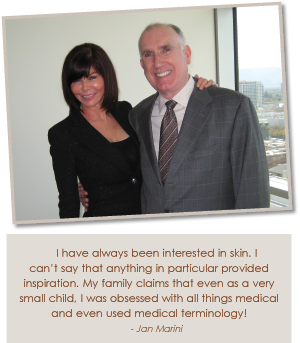To start your skin care center, even if it consists of a single room, you must be fully prepared to devote yourself to 12-hour days, seven days a week, for an indeterminate amount of time. This is true even if you hire other people. If you’re newly married, have a new baby, have young children, have a serious care taking role—even have a new puppy!—your timing probably is not right to launch a new business.
2 - ARTICULATE A CLEAR VISION. Your vision should be clear enough in your mind to express in one simple, powerful description of your business. Consider these as examples: “A detoxifying environment for urban skin” or “A restorative program for aging skin, as an alternative to cosmetic surgeries and invasive procedures.”The exercise of writing down your vision, which in turn becomes your mission statement, underscores a key truth: you cannot be all things to all people. Keep it clear, limited, and narrow in focus.
3 - INTEGRATE EVERYTHING INTO YOUR VISION. Consistency of vision, image and implementation are key. Once your vision is articulated with clarity, then your challenge becomes creating an integrating, compatible meshing of every aspect of your business with this defining vision. For instance, if your primary interest is offering professional skin care as a viable alternative to clinical medical services, but your gum-chewing staff favors torn fishnet stockings, leather minis and jumbo hoop earrings—you’ve got an instant credibility gap in terms of image. Ditto if your mission is to create a Zen oasis in the heart of Manhattan, but your décor involves leopard-print sofas and bad, gold-leafed copies of Greco-Roman statuary. Aim for consistency bordering on monotony—it’s a proven fact that repetition sells.
4 - WRITE A POLICY AND PROCEDURES MANUAL FOR EMPLOYEES. Again, having to articulate the details will help to clarify and cement these ideas in your own mind. For instance, have a clear policy with how to deal with client cancellations. Lay out every detail you can think of, including sample scripts for dealing with clients. The exchange between a client and your staff should always be essentially the same in terms of the client-employee interaction. The phone should be answered the same way every day, regardless of who takes the call. The basic presentation of information and treatment options should be the same with every therapist and every client.
Naturally, individual personalities will nuance everything, but the core structure must be consistently understood, honored and obeyed! Remember that your business really is not the venue for other people’s self-expression—this leads to chaos.
5 - HIRE FOR ATTITUDE. Skill can be learned. Bad attitude may, theoretically, be UN-learned, but it’s an ugly process and really not your problem. Offer employees a “no strings attached”, 2- to 4- week trial apprenticeship, with the understanding that either party may terminate during that time without any fuss.
During that two weeks, look for red flags. Lateness is a classic signal of stormy weather to come. Psychologists generally agree that chronic lateness is a signal of passive aggression—rather than expressing hostility by showing up and being hostile, the passive-aggressive personality expresses hostility simply by not showing up!
Look for other signs of trouble, such as a bristle of resentment over a change in schedule or difference of opinion, or other indicators of deep, masked anger. Anger takes myriad forms, and is often at the heart of destructive employee behavior.
6 - WRITE YOUR MENU BASED ON BENEFITS, NOT FEATURES. Keeping congruent with your vision and mission, refrain from making your menu too flowery or too elaborate. Don’t go on and on about the fabulous ingredients alone—talk about what they will actually do for the SKIN.
In our experience, this is a valuable experience on a number of levels. Too many skin care menus get carried away with frou-frou ingredients (caviar, rose-petals, chocolate mousse, tourmaline dust and, yes, nightingale droppings), which would be more at home in a fairytale, than on the face of a client. Can you honestly, seriously claim that your novelty treatment with its glamorous or simply outlandish ingredients will really improve their fine lines and hyperpigmentation?
Writing your menu should be a kind of reality check. Stay focused on your mission, who you are committed to serving, and what you really want to accomplish for them. We’re in favor of only offering a few specific treatments (for acne, sun damage, deep hydration, stress), and steering clear of gimmicks. It’s fine to offer a lighthearted seasonal promotion—an Irish Oatmeal treatment on St. Patrick’s Day!—but don’t make these whimsical things your core service.
7 – CONSIDER THAT YOU MAY WANT TO CREATE TWO ENVIRONMENTS—or THREE! This is a tough one for a lot of therapist/owners to even imagine, much less implement.
But the fact is that there are at least three distinct zones to your business: the entry, the treatment area, and the retail area. The entry/check-in and retail areas should be linked, because their energy-level and overall vibe should be the same. These are public areas, and “extroverted” areas, meaning that staff should interact with clients in a lively, upbeat, sales-minded manner. The mission is to “sell” in subtle ways—meaning to simply make it easy for the client to buy, whether she is buying another appointment (front desk people must be skillful at rebooking!) or buying product off the shelf.
Front desk staff must be groomed to the max, chipper, and sunny, with fantastic personality and eye contact from the moment the client crosses the threshold. The colors in the entry and retail space should be bright and warm—clear aquamarine and citrusy light yellow-green are fresher and more interesting alternatives to white. And the music should be bright and upbeat as well, percussive enough to make the body perk up in response.
By contrast, the treatment room is semi-dark, and the client is semi-naked and will soon be semi-conscious! The experience is private, and “introverted”. The client withdraws her energy into herself during the treatment. The room should offer mental as well as physical sanctuary. Colors should be soft and soothing – again, clinical white is not the only choice. Renaissance velvet tones such as deep gold, olive and burnished terra cotta may give a richer feeling, even when painted on a single wall. Music is at the discretion of the client, although extraneous sounds (such as music from the retail area!) must be muffled.
In short, you really need to create two worlds, ideally. These two worlds are the Yin and Yang of the professional skin treatment. They contrast, but must not conflict—and their successful creation may require the services of a designer and feng shui expert.
8- HYGIENE RULES. Décor is subjective. Hygiene is not. Our research tells us that 80 percent or so of all skin center clients, as well as clients of spas, nail salons, etc., take their business elsewhere because they are turned off and grossed out by bad hygiene on the premises.
One of our pet peeves: employees who eat or drink in sight of clients. This cannot be permitted—not even a diet Coke by the register. To draw from an actual real-life experience in another industry, imagine having a pedicure while the nail tech munches her turkey sandwich with one hand and works the callous file with the other. This is tough to take—and we would think that it would be even tougher on the nail tech! Anyway, all food and drink must be consumed away from clients.
The bathrooms—need we say more? They must sparkle and smell like mint, lemons, oranges, limes, rosemary, lavender. There must be ample paper supplies of all types, within easy reach. There must be excellent lighting, and excellent ventilation. The wastebasket must never be allowed to fill up, even if it is a closed-top design.
Hygiene is one area where we share a common culture with our more medical colleagues. Although no one is doing surgery in your skin care center, the level of bacterial activity should be as low as you can get it!
9- PLAN NOW FOR RETAINING CLIENTS. When you’re first opening your doors, you’re so consumed by the immediate moment that it’s hard to think ahead into the future. But getting clients through the door for the first time is only half of the challenge. The other half is keeping them coming back.
You need to strategize with your team, as well as with other entrepreneurial colleagues: how to keep clients re-booking every 4 – 6 weeks? Promotions are one method. We don’t recommend discounting, as it erodes your brand integrity. Promotions, rather than offering a reduced price, fold in an added service or “added value” of a GWP.
Begin building your database, NOW. Send postcards. Create an interesting newsletter.
Build a brand alliance with another company and create an exclusive “shared” offer for your collective clients. For instance, invite clients to leave their business cards or fill out a card, which you wish to share with the charming pastry shop down the street. As part of the exchange, your clients enjoy a free pot of gourmet tea with their meal purchase. The pastry-shop’s clients get a 15-minute aromatherapy massage with their treatment from you.
Or link your business to a larger community cause, such as creating a community garden in the neighborhood. Enlist the green thumbs of your clients and their families, and offer a small, trial-size product (sunscreen) for their participation. Take a group photograph at the garden (or whatever the event may be) and run it on your website. In this way, you are creating a mini-community or “tribe” among your own clients. This camaraderie is very strong, and breeds loyalty. Think about the group of women in your favorite class at the gym. Some of us have been willing to drive TOTALLY out of our way when we change residences or change job locations, just to stay in our class, and with our group. Women’s tribal bonds are fierce! Make the most of them!
10 – DEVELOP A STRATEGY TO LOCATE NEW CLIENTS. This spills out of your retention plan. The fact is that clients do leave your database. It isn’t even necessarily your fault! Our society is highly volatile, and highly mobile. People relocate, or take on new responsibilities which change their schedules, and so on, so expect some attrition.
The ideas mentioned above may be adapted to draw new clients as well as retain existing ones. We’re not huge fans of local advertising, by the way—although inserting your menu (yes, you pay for this) into the local city magazine is often effective.
Rather, we believe that all successful businesses, even those, which advertise, are actually built by word-of-mouth. And to do this, you need to build connections with clients. These connections form relationships. The client must always know and believe that her business is your top priority. This is especially important when juggling schedules – be careful never to make clients feel that they’re just “bricks in the wall”, to quote Pink Floyd!
Strive for connection, and relationship. Strive for consistent excellence. Strive for simplicity and purity of vision and mission—and most of all, enjoy your journey!
 Annet King, Director of Training and Development for The International Dermal Institute (IDI), is both CIDESCO and CIBTAC certified with more than 18 years of skincare industry experience. Her responsibilities include overseeing the vast IDI teaching staff around the globe, as well as developing the curriculum taught in all 45 countries. Her dynamic personality paired with her expertise make her one of the most in-demand guest speakers at educational events worldwide.
Annet King, Director of Training and Development for The International Dermal Institute (IDI), is both CIDESCO and CIBTAC certified with more than 18 years of skincare industry experience. Her responsibilities include overseeing the vast IDI teaching staff around the globe, as well as developing the curriculum taught in all 45 countries. Her dynamic personality paired with her expertise make her one of the most in-demand guest speakers at educational events worldwide.
Yve Cole-Poy, Business Development Manager for Dermalogica, a skin therapist with more than 25 years of experience who also managed Dermalogica’s innovative Leonard Drake locations in the USA, provides a consulting service and support to Dermalogica accounts on business building, marketing, operational planning and management of their centers.





 Those who know Jan Marini refer to her as a visionary. While Jan might agree in principle, she sees this characterization as both a strength and a weakness. She envies those who are able to savor the moment. Where others view life in snapshots that capture real time, Jan sees broad borderless landscapes and endless possibilities. She does not see a product, she sees a business and in that same instance her mind is flooded with the business plan and all the accompanying details. Even when she is not envisioning empires, she is never satisfied with the status quo.
Those who know Jan Marini refer to her as a visionary. While Jan might agree in principle, she sees this characterization as both a strength and a weakness. She envies those who are able to savor the moment. Where others view life in snapshots that capture real time, Jan sees broad borderless landscapes and endless possibilities. She does not see a product, she sees a business and in that same instance her mind is flooded with the business plan and all the accompanying details. Even when she is not envisioning empires, she is never satisfied with the status quo.